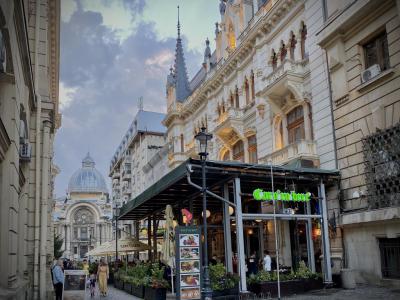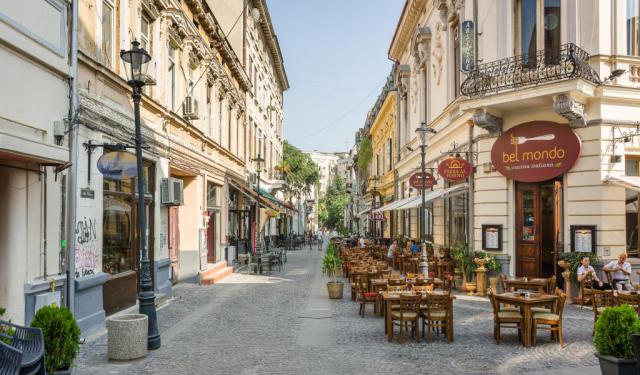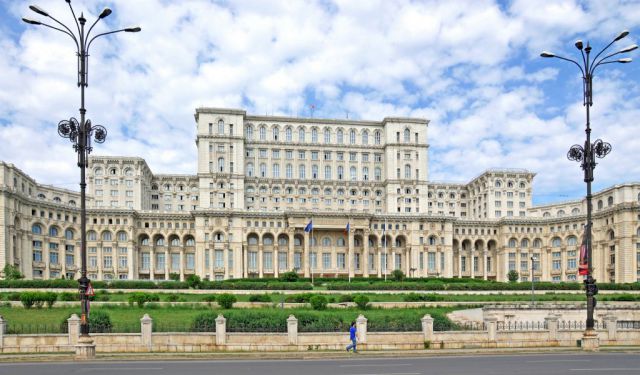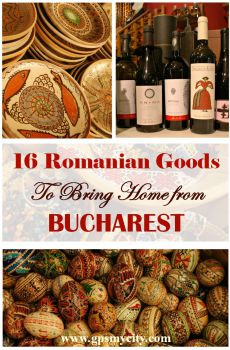
Caru’ cu Bere (The Beer Wagon), Bucharest
Caru' cu Bere ("the beer wagon") is a bar and restaurant on Stavropoleos Street in the Lipscani district of Bucharest. The business was originally opened as a brewery in 1879 by Ioan Căbășan and his nephews, Ion, Gheorghe, and Nicolae Mircea. They were originally citizens of the Austro-Hungarian Empire and from Cața, Transylvania. In 1889, Căbășan assigned his lease to his eldest nephew, Ion. Ion died later that same year and was replaced in the family firm by the youngest sibling, Víctor.
Nicolae bought the building on Stavropoleos Street in 1897, and made plans to open a restaurant there to expand their business operations. They hired the Austrian architect Siegfrid Kofczinsky to design a restaurant and brewery building in the gothic revival style. Co-owners were Nicolae, Ignat, and Víctor Mircea. The restaurant opened in 1899, featuring their beer. Victor left the establishment in 1912, opening his own brewery and several years later, Nicolae set up Ignat in a wine cellar business. When Nicolae died in 1929, his heirs assumed control of the business and operated it until the communist state nationalized the operation in 1949.
In 1986, extensive restoration was done on the property, led by Nicolae Gheorghe. When the Socialist Republic of Romania was overthrown in 1989, the heirs of the Mircea family began efforts to regain their ownership. In 1999, Caru' cu Bere was returned to them and they began extensive renovations to restore the property to its former state. It is noted for its distinctive art nouveau interior decoration. It is operated by Dragoș Petrescu's City Grill chain, and is classified as a historic monument.
Romanian writer Mateiu Caragiale's frame story, Sub pecetea tainei, is set in Caru' cu Bere.
Nicolae bought the building on Stavropoleos Street in 1897, and made plans to open a restaurant there to expand their business operations. They hired the Austrian architect Siegfrid Kofczinsky to design a restaurant and brewery building in the gothic revival style. Co-owners were Nicolae, Ignat, and Víctor Mircea. The restaurant opened in 1899, featuring their beer. Victor left the establishment in 1912, opening his own brewery and several years later, Nicolae set up Ignat in a wine cellar business. When Nicolae died in 1929, his heirs assumed control of the business and operated it until the communist state nationalized the operation in 1949.
In 1986, extensive restoration was done on the property, led by Nicolae Gheorghe. When the Socialist Republic of Romania was overthrown in 1989, the heirs of the Mircea family began efforts to regain their ownership. In 1999, Caru' cu Bere was returned to them and they began extensive renovations to restore the property to its former state. It is noted for its distinctive art nouveau interior decoration. It is operated by Dragoș Petrescu's City Grill chain, and is classified as a historic monument.
Romanian writer Mateiu Caragiale's frame story, Sub pecetea tainei, is set in Caru' cu Bere.
Sight description based on Wikipedia.
Want to visit this sight? Check out these Self-Guided Walking Tours in Bucharest. Alternatively, you can download the mobile app "GPSmyCity: Walks in 1K+ Cities" from Apple App Store or Google Play Store. The app turns your mobile device to a personal tour guide and it works offline, so no data plan is needed when traveling abroad.
Caru’ cu Bere (The Beer Wagon) on Map
Sight Name: Caru’ cu Bere (The Beer Wagon)
Sight Location: Bucharest, Romania (See walking tours in Bucharest)
Sight Type: Food/Drink
Guide(s) Containing This Sight:
Sight Location: Bucharest, Romania (See walking tours in Bucharest)
Sight Type: Food/Drink
Guide(s) Containing This Sight:
Walking Tours in Bucharest, Romania
Create Your Own Walk in Bucharest
Creating your own self-guided walk in Bucharest is easy and fun. Choose the city attractions that you want to see and a walk route map will be created just for you. You can even set your hotel as the start point of the walk.
Old Town Walking Tour
The Historical Center of Bucharest, or the Old Town, as the locals habitually refer to it, is one of the most beloved and attractive areas in the Romanian capital. The neighborhood is really beautiful a place to visit, and you can walk into it pretty much from anywhere in central Bucharest. Ion Constantin Brătianu Boulevard crosses the historic heart of the city from Piata Universitate... view more
Tour Duration: 2 Hour(s)
Travel Distance: 1.9 Km or 1.2 Miles
Tour Duration: 2 Hour(s)
Travel Distance: 1.9 Km or 1.2 Miles
Bucharest Introduction Walking Tour
Bucharest, the capital and cultural center of Romania, is one of the largest cities in Southeastern Europe.
The name București has an unverified origin. Tradition links it to the guy named Bucur, who (according to various legends) was either a prince, outlaw, fisherman, shepherd or a hunter. The Romanian word “bucurie” means joy (happiness), which in turn explains one of Bucharest's... view more
Tour Duration: 2 Hour(s)
Travel Distance: 3.7 Km or 2.3 Miles
The name București has an unverified origin. Tradition links it to the guy named Bucur, who (according to various legends) was either a prince, outlaw, fisherman, shepherd or a hunter. The Romanian word “bucurie” means joy (happiness), which in turn explains one of Bucharest's... view more
Tour Duration: 2 Hour(s)
Travel Distance: 3.7 Km or 2.3 Miles
Useful Travel Guides for Planning Your Trip
16 Uniquely Romanian Things To Buy in Bucharest
Nicknamed "Little Paris", today's Bucharest is the capital of a vibrant European nation, known as Romania, with lots of history and great cultural heritage - spanning from centuries-old rural traditions to New Wave cinema. Keen on rustic stuff, Romanians carefully preserve their...



